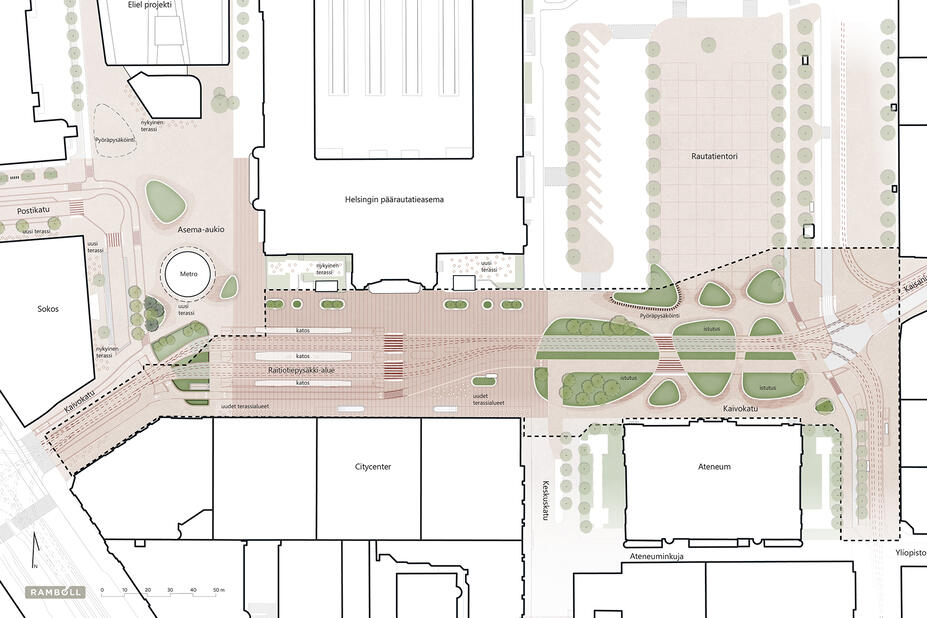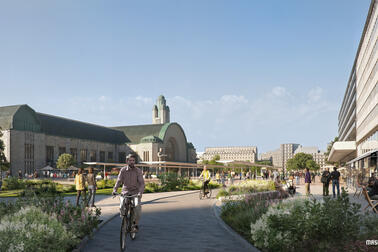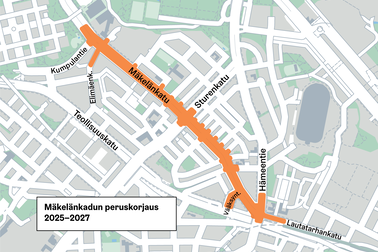
The amendments to Kaivokatu's local detailed plan began in spring 2025. They are based on the city centre's transport system plan approved in 2024, in which it was decided that Kaivokatu would be converted into a public transport street. At the same time, transverse car traffic in the centre will be concentrated on the two Esplanadi streets.
The draft plan materials can be viewed online from 17 November to 16 December 2025. The plans for Kaivokatu will be presented to residents at the City Hall's event market on Thursday 20 November at 17:00–18:30. The event can also be watched live or as a recording on Helsinki Channel(Link leads to external service) .
Space for pedestrians and places to stop in front of the Central Railway Station
The area around the Central Railway Station is the main public transport hub in the Helsinki region, with the highest pedestrian volumes in the city. Around 185,000 passengers arrive and depart by public transport daily. However, city residents feel that the area is the most unpleasant one to move through in the city centre.
The area in front of the station's main doors is currently cramped. There is no place for those coming out of the station to stop without getting in the way of other people. Not everyone waiting for the traffic lights to change can fit in the waiting area of the zebra crossing leading to the tram stop. Additionally, the cycle path regularly causes dangerous situations between pedestrians and cyclists.
The solution proposed in the new local plan allows the pedestrian areas in front of the railway station to be expanded and unified, which will improve the flow, comfort and safety of walking. The pedestrian space on Kaivokatu will be transformed from pavements bordering car lanes to a plaza-like area where people can move freely in different directions.
Street space will also be freed up for plants, benches and services. The improvements will calm down the space around the area's historic landmark buildings and give the buildings greater prominence. The addition of plants will soften the look of the area and provide a contrast to the stony surfaces and the built environment. The space will no longer be just a place to pass through, but will also provide a calmer area for waiting and meeting others.

The number of tram stops will double
Going forward, Kaivokatu will have two tracks for trams, branching into four at the stops. The plan is to place four tram stops on Kaivokatu instead of the current two. The stops will be 61 metres long, allowing two city trams or one light rail tram to stop at the same platform at the same time.
At its busiest, tram traffic on Kaivokatu will reach up to about 40 services an hour per direction. Pedestrians can cross the street almost continuously without delays. Two light-controlled crossings will remain on Kaivokatu, located at the main doors of the railway station and in front of Ateneum. At other crossings, pedestrians must give way to the tram. In connection with the planning work, it has been found that reducing street crossings and especially traffic lights speeds up pedestrian travel by up to 20–50 seconds and tram travel by as much as over a minute.

Cars will have access close to the railway station
Kaivokatu is currently used by 15,000–20,000 vehicles per day. Based on the traffic modelling, the majority of car traffic would shift to alternative routes, such as the Esplanadi streets, Helsinginkatu and Nordenskiöldinkatu, due to changes on Kaivokatu. This may increase journey times in the city centre by a few minutes. Some car traffic will be diverted to bypass the city centre entirely.
Drop-off traffic to the Central Railway Station will continue to be possible by car and taxi from different directions. Space will be reserved for drop-off spots on Kaivokatu and the Asema-aukio square. The change would appear to speed up car journeys to the station, as there will no longer be through traffic on the routes leading to the station. Connections to the parking facilities around Kaivokatu will be maintained, but the routes to them will change. Kaivokatu will remain a through route for the rescue services.
The construction will begin in 2028
The street and construction planning of Kaivokatu is underway and is being promoted simultaneously with the preparation of the local detailed plan. The construction of Kaivokatu is planned to be carried out in two phases. In the first phase, in 2028–2029, the waterproofing of the Kaivokatu deck and the municipal engineering on the street will be renewed, stormwater drainage in the area will be improved and flood risk reduced, and the necessary modifications and ducts for the metro station's renovation will be implemented. The streets will be resurfaced and their quality will be upgraded. The conversion of Kaivokatu into a public transport street can be carried out once the renovation of the Esplanadi streets is completed.


